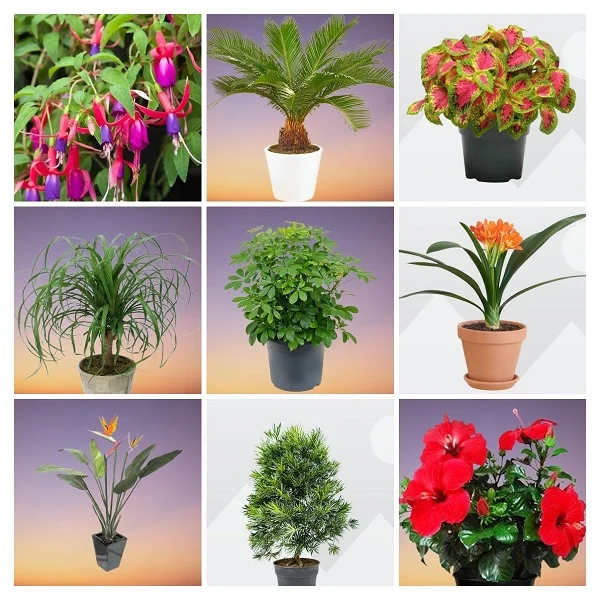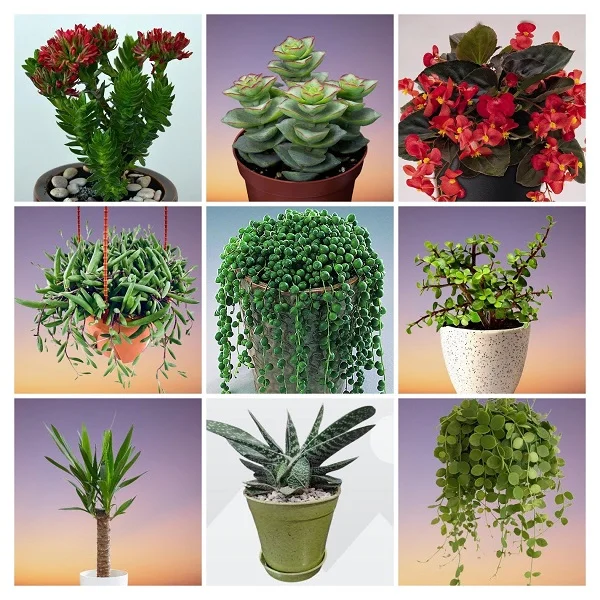17 Purple-leaved Houseplants to Add a Splash of Color in the Home
Some links in this post may be affiliate links
Are you looking to add a pop of color in your home? Purple-leaved plants are some of the best choice for this purpose. The Purple color is associated with royalty, rarity and mystery.
In addition, plants with purple leaves are magnificent for add a splash of color among the greenery as well as creating an unprecented level of interest in your home.
We have herebelow a list of 17 Purple Leaf Houseplants from which you can make your selection. Keep reading for more on these Purple Plants.
17 Purple Indoor Plants for Your Home
The best Purple-leaved Plants are Persian Shield Plant, Silver Inch Plant, Purple waffle Plant, Purple Passion Plant, Purple Heart Plant, Painted-leaf Begonia, Leea Burgundy among others.
1. Persian Shield Plant (Strobilanthes dyerianus)
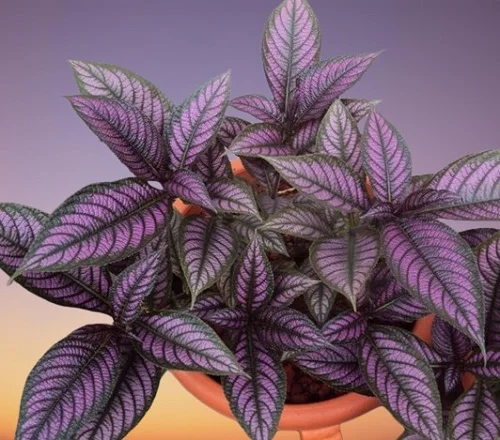
Persian Shield Plant also called Royal Purple Plant or Bermuda Conehead is an erect evergreen shrub which bears finely-toothed, dark-green foliage with bright, metallic-purple stripes radiating outward from the central leaf vein.
However, this appearance of Royal Purple Plant declines with age as the old plants are straggly, the color fades and the foliage becomes silvery with dark veins.
Strobilanthes dyerianus blossoms in bright indirect light, warm and humid conditions and consistently moist, rich, well-drained soil coupled with fortnightly feeding during the growing season.
Learn more on how to grow and care for Persian Shield Plant
2. Silver Inch Plant (Tradescantia zebrina)
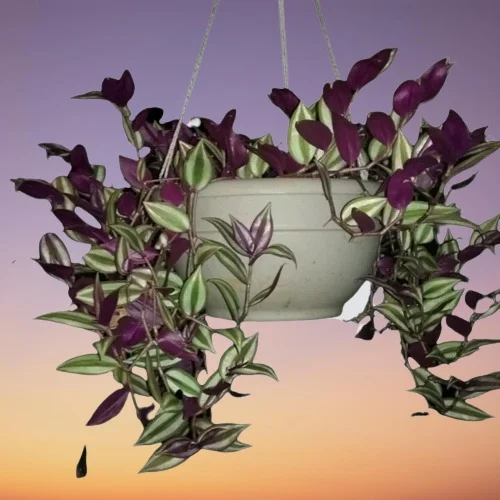
Silver Inch Plant bears glistened leaves which are multicolored above where the surface color is bluish-green, banded with silver and edged in purple.
Some common varieties of Tradescantia zebrina are Zebrina purpusii (Bronze Inch Plant) with purplish-green leaves and purple underside and is Zebrina pendula quadricolor which is more showy with green, silver, pink and red leaf surface with a purple underside.
Tradescantia zebrina grows best under bright indirect light, average warmth and moderately moist, fertile, well-drained soil coupled with fortnightly feeding in the growing season.
Read more on how to grow and care for Silver Inch Plant
3. Purple waffle Plant (Hemigraphis alternata)

Purple Waffle Plant also called Red Flame Ivy, Metal Leaf Plant or Red Ivy is a climbing plant whose leaves are silvery in the shade and metallic purple when grown under some direct sunshine.
Red Flame Ivy is perfect for a hanging basket where the stems can beautifully cascade downwards to display the beauty of the metallic leaves. Apart from Hemigraphis alternata, the other common variety is Hemigraphis exotica which has puckered leaves.
Hemigraphis alternata prefers bright light with some direct sunlight, warm and humid conditions and consistently moist, rich, well-drained soils coupled with fortnightly feeding during the growing season.
Learn more on how to grow and care for Purple waffle Plant
4. Purple Passion Plant (Gynura)
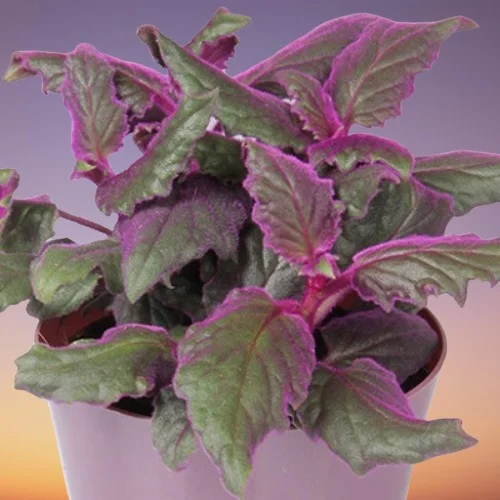
Purple Passion Plant also called Velvet Plant is a popular plant whose foliage is covered with shiny purple hairs and is perfect for adding a splash of color in any space.
Some common Gynura species for indoors are Gynura sarmentosa, a trailer, whose foliage is gleaming purple in bright light, Gynura aurantiaca, with larger leaves and is more upright and Gynura procumbens, a trailer, whose leaves are deep-burgundy colored at the bottom.
Gynura species blossom in bright light with some direct sunlight, warm and humid conditions and moderately moist, fertile, well-drained soil coupled with fortnightly feeding during the growing season.
5. Purple Heart Plant (Tradescantia pallida)
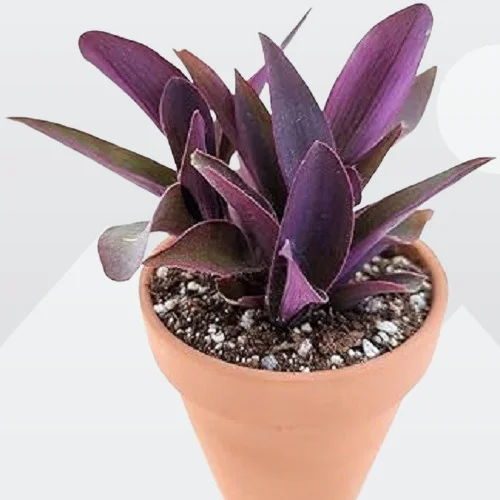
Purple Heart Plant also called Purple Queen Plant bears leaves which are elongated, pointed, slightly hairy, glaucous green, fringed with red or purple.
The flowers in Purple Queen Plant are small, sterile, three-petaled and are white, pink or purple. The stems are clearly segmented and roots easily grow from the joints.
Tradescantia pallida does best under bright indirect light, average warmth away from drafts and moderately moist, fertile, free-draining soil coupled with fortnightly feeding during the growing season.
Learn more on how to grow and care for Purple Heart Plant
6. Painted Nettle (Coleus blumei)
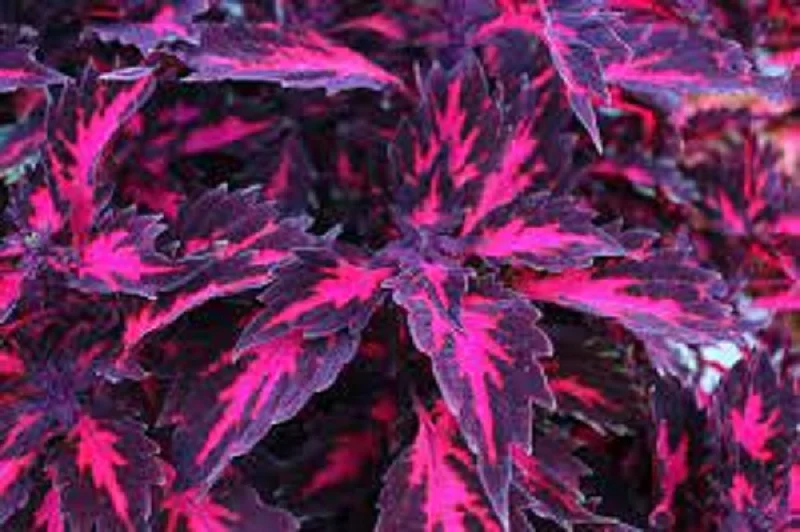
Painted Nettle or simply Coleus offers a multicolored display of foliage and a bewildering choice of hybrids making beautifully colored plants.
There are numerous Coleus cultivars which come in almost every conceivable mixture can be found. There are some attractive single-colored varieties but the usual choice is for the multi-colored varieties like the Stained Glassworks Royalty cultivar (in the photo).
Coleus blumei grows best in very bright light, average warmth and consistently moist, fertile, well-drained soil coupled with regular feeding during the growing season.
Read more on how to grow and care for Painted Nettle
7. Painted-leaf Begonia (Begonia Rex)
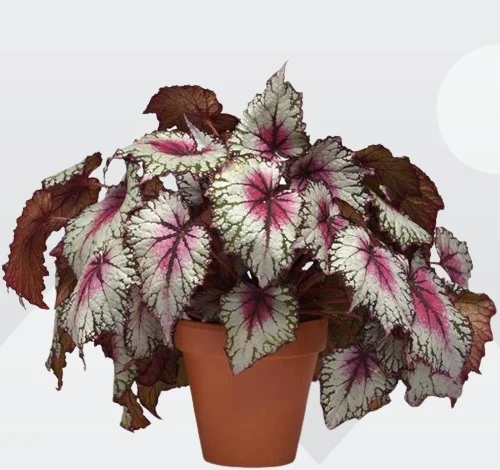
Painted-leaf Begonia or Fancy Leaf Begonia is an easy to grow Begonia which is grown for its foliage display where the large, lop-sided, spectacular leaves occur in various hues.
The Painted-leaf Begonia grows to a height of 1-2 ft and about the same width. It bears large lop-sided leaves about 6-12 in. long and 4-5 in. wide with a hairy leaf stalk.
Begonia Rex prefers bright indirect light with some direct sunshine, average warmth, humid conditions and moderately moist, rich, well-drained soil coupled with fortnightly feeding during the growing season.
Learn more on how to grow and care for Painted-leaf Begonia
8. Leea Burgundy (Leea coccinea)
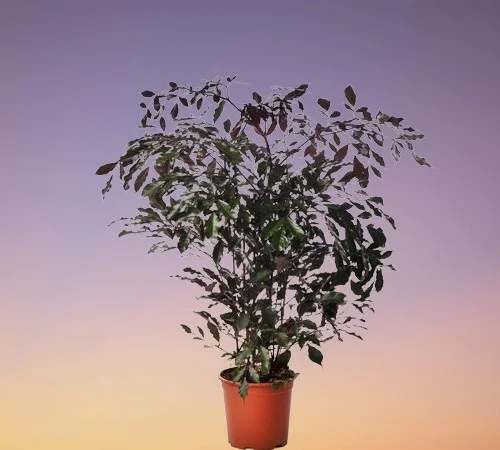
Leea Burgundy also called Red Leea, Hawaiian Holly or West Indian Holly 'Rubra' is a rare plant but is among the popular tree-like plants whose foliage in young plants is bronzy red but turns green when mature.
Leea coccinea also called Leea guineensis can grow to a height of 6-8 feet and a width of about 4-5 feet. It produces red flowers which later turn pink and the fruits are black berries.
Leea coccinea thrives in in medium to bright light (filtered light), warmth of 18-290C, humidity of 50-55% and consistently moist, fertile, well-drained soil coupled with monthly feeding during the growing season.
Read more on how to grow and care for Leea Burgundy
9. Boat Lily (Tradescantia spathacea)
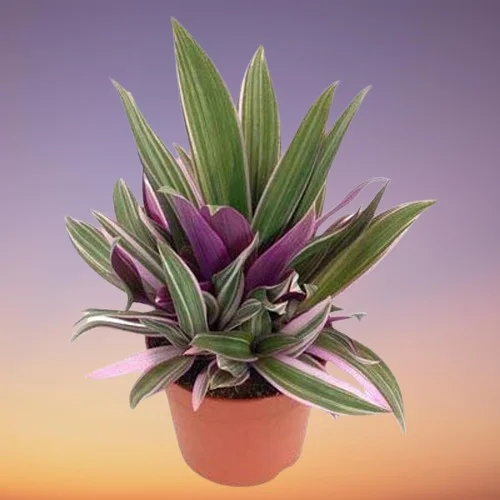
Boat Lily also called Moses-in-the-Cradle, Moses-in-a-Boat, Cradle Lily or Oyster Plant bears fleshy, sword-shaped, glossy green with purplish-red undersides.
The Cradle Lily bears small white flowers in purple 'boats' at the base of the lower leaves and hence the common names, 'Moses-in-the-Cradle', 'Boat Lily' and 'Moses-in-a-Boat'.
Tradescantia spathacea grows best in bright indirect light, average warmth and moderately moist, fertile, well-drained soil coupled with monthly feeding during the growing season. It has no need for high humidity.
Learn more on how to grow and care for Boat Lily
10. Alocasia cuprea
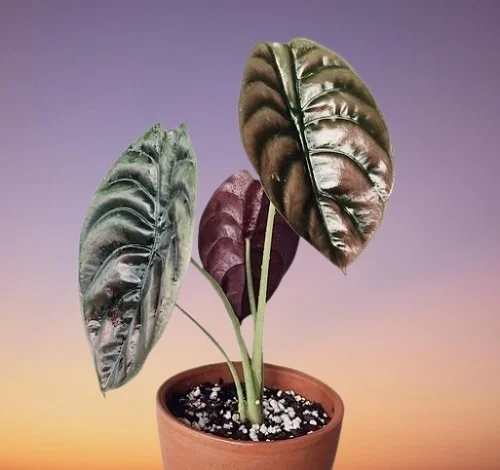
Alocasia cuprea is a small plant which bears enormous, spherical, green leaves with a metallic gloss, pronounced leaf veins and deep-purple undersides.
The Alocasia cuprea is a slow growing plant which grows to a height of 1 ft in about 2 years. The leaves are enormous and can grow to 1 ft long.
Alocasia cuprea blossoms in bright indirect light, warm and humid conditions and consistently moist, rich, well-drained soil coupled with regular feeding during the growing period.
Read more on how to grow and care for Alocasia cuprea
11. Calathea Jungle Velvet (Calathea warscewiczii)

Calathea Jungle Velvet is one of the delightful Calathea plants varieties and bears beautifully patterned leaves with purple-toned undersides and a velvety feel.
Calathea warscewiczii also called Goeppertia warscewiczii like Calathea veitchiana (Calathea Medallion), Goeppertia insignis (Rattlesnake Calathea) and Calathea bachemiana (Goeppertia bachemiana) are popular purple-leaved plants which will create a spectacular sight in any space.
Goeppertia warscewiczii blossoms in medium to bright indirect light, warmth of 16-280C, humidity of 60-80% and consistently moist, fertile, well-drained soil coupled with monthly feeding during the growing season.
Learn more on how to grow and care for Calathea Jungle Velvet
12. Ti Plant (Cordyline terminalis)

Ti Plant also called Hawaiian Goodluck Plant, Hawaiian Ti Plant or Polynesian Ti is a popular plant ideal for adding a splash of color among the greenery.
Ti Plant is a compact False Palm which grows to a height of about 1-2 feet. The leaves are broad, about 2 feet long and are usually tinged or splashed with red or purple.
Cordyline terminalis requires bright indirect light, average warmth and moderately moist, fertile, well-drained soil coupled with monthly feeding during the growing season.
Read more on how to grow and care for Ti Plant
13. Bronze Rubber Plant (Ficus elastica 'Robusta')
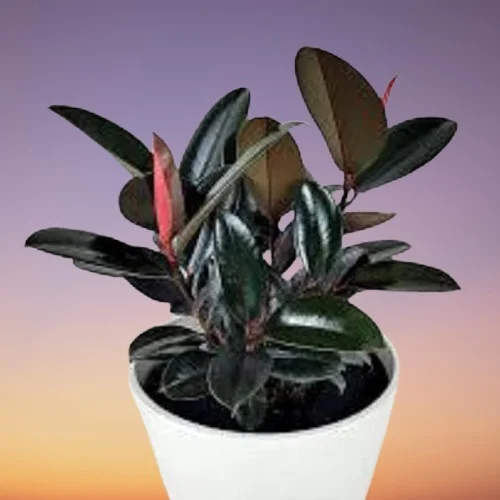
Ficus elastica 'Robusta' also called Bronze Rubber Plant bears large, wide, purplish-green leaves which emerge surrounded by a red sheath.
Bronze Rubber Plant is a more compact Rubber Plant which grows to a height of about 4-6 feet. The plant branches more freely and can withstand low humidity.
Ficus elastica 'Robusta' blossoms in bright light with some direct sunlight, warm and humid conditions and moderately moist, fertile, well-drained soil coupled with monthly feeding during the growing season.
Learn more on how to grow and care for Rubber Plant
14. String of Rubies Plant (Othonna capensis)
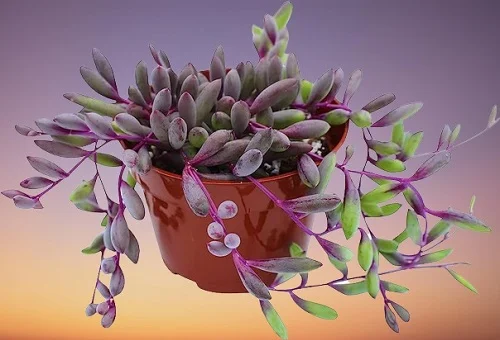
String of Rubies Plant also called String of Pickles, Little Pickles or Ruby Necklace is characterized by thin, oval-shaped leaves and reddish-purple stems.
The String of Pickles Plant grows as a trailer, with stems trailing on the ground, rooting where they touch and forming dense mats. The leaves turn a bright ruby red when the plant is grown under bright sunshine.
Othonna capensis blossoms in very bright light, average warmth and moderately moist, fertile, well-drained soil coupled with two feedings during the growing season. It has no need for extra humidity.
15. Stromanthe Triostar (Stromanthe sanguinea)
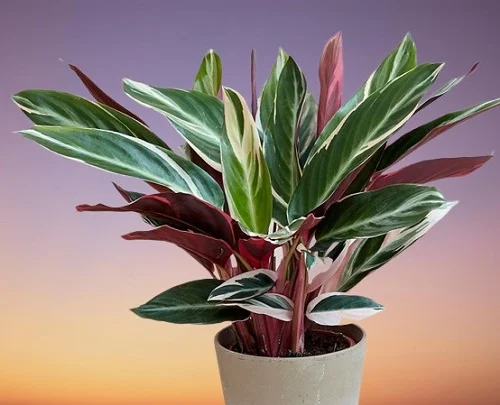
Stromanthe triostar or Tricolor Prayer Plant is a herbaceous perennial plant that is grown indoors for its strikingly beautiful foliage with purple undersides and is a pleasant addition to any plant collection.
The Tricolor Prayer Plant is a slow growing plant which grows to a height of about 6 ft and a diameter of about the same size. It is one of the best tropical foliage plants that will add color in any space.
Stromanthe sanguinea prospers in bright indirect light, warm and humid conditions and consistently moist, rich, well-drained soil coupled with monthly feeding during the growing season.
Read more on how to grow and care for Stromanthe Triostar
16. Aeonium arboreum 'Zwartkop'
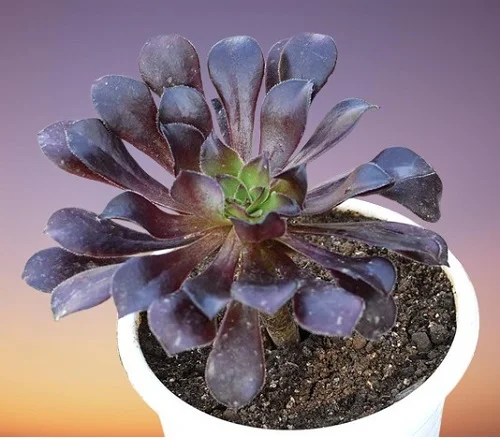
Aeonium arboreum 'Zwartkop' ('Schwartzkopf') also called Aeonium Black Rose is a purple cultivar of Aeonium arboreum which has gained the Royal Horticultural Society's Award of Garden Merit.
Aeonium Black Rose can withstand more direct sunlight than other varieties to enhance the leaf color; the stronger the sunlight, the darker it becomes.
Aeoniums will flourish in bright light with some direct sunlight, average warmth and moderately moist, fertile, sandy loam soil coupled with monthly feeding during the growing season.
Learn more on how to grow and care for Aeoniums
17. Eternal Flame Plant (Calathea crocata)
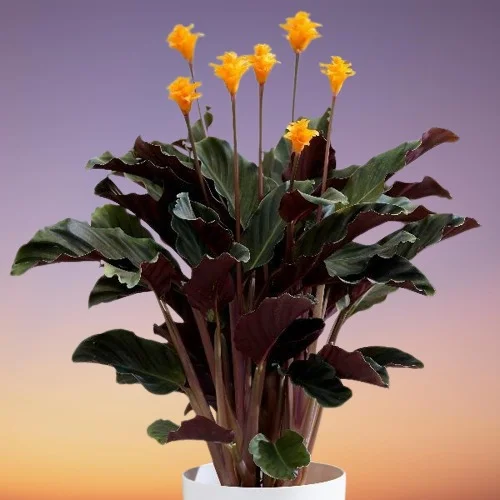
Eternal Flame Plant or Saffron-coloured Calathea bears magnificent, slightly wrinkled metallic dark-green leaves with purple to brown tones on the undersides and a display of erect orange-red flowers.
Saffron-coloured Calathea bears magnificent, slightly wrinkled, metallic, dark-green leaves with purple to brown tones on the undersides. On account of its magnificent foliage and striking blooms, Calathea crocata is among the best plants for the office space where it will create a great first impression
Calathea crocata prefers bright indirect light with 4 to 6 hours of sunlight, warmth of 18-260C, humidity of 70-80% and moderately moist, fertile, well-drained soil coupled with monthly feeding during the growing season.
Learn more on how to grow and care for Eternal Flame Plant
